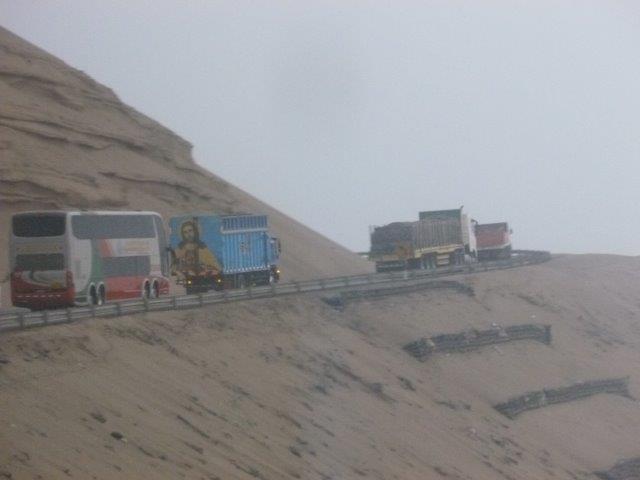The trip to Huaraz is long, but comfortable on the Cruz del Sur bus that has reclining seats with plenty of leg room.
At $26 per person for an 8 1/2 hour trip, it's about the price we would have paid for the three of us to take a taxi to the airport from our house in Indianpolis.
The first two hours of the trip follow the coastline, with enormous eroded sand dunes on the east side of the road that look like they could come sliding down at any minute.
As we begin to follow the course of one of the rivers that flows down from the mountains, we see lots of greenery in the river bed, but the rest of the land remains barren. Where the river valley is flatter and wider, there are large plantations of sugar cane.
(Yes, that's Jesus waving at us from the back of the truck. You see a lot of religious imagery everywhere in a country that is officially Catholic.)
We pass the Hari Krishna complex just before the road turns eastward and we start climbing through the high desert.
We occasionally pass an enormous chicken farm or a settlement of families living in makeshift houses (who probably work at the chicken farms). We see foot trails in the sand where people have walked long distances over the dunes, and "private property" signs placed by mining companies to mark their claims. There's no vegetation at all as far as the eye can see.
We pass the Hari Krishna complex just before the road turns eastward and we start climbing through the high desert.
We occasionally pass an enormous chicken farm or a settlement of families living in makeshift houses (who probably work at the chicken farms). We see foot trails in the sand where people have walked long distances over the dunes, and "private property" signs placed by mining companies to mark their claims. There's no vegetation at all as far as the eye can see.
As we begin to follow the course of one of the rivers that flows down from the mountains, we see lots of greenery in the river bed, but the rest of the land remains barren. Where the river valley is flatter and wider, there are large plantations of sugar cane.
We see many places where corn -- yellow, orange or purple -- is being dried by the side of the road, spread out directly on the rocky terrain.
As we proceed further east, we make the transition from desert to forest. The hills are still barren at the top, but we see more and more plant life -- first grasses, then bushes and trees. The last part of the trip proceeds much more slowly, averaging 20 or 30 miles per hour, as we wind our way into the Andes mountains. The bus driver pauses and honks at each curve of the switchbacks to alert other vehicles that he's about to make a wide turn into the oncoming lane in order to navigate the curve.
As we proceed further east, we make the transition from desert to forest. The hills are still barren at the top, but we see more and more plant life -- first grasses, then bushes and trees. The last part of the trip proceeds much more slowly, averaging 20 or 30 miles per hour, as we wind our way into the Andes mountains. The bus driver pauses and honks at each curve of the switchbacks to alert other vehicles that he's about to make a wide turn into the oncoming lane in order to navigate the curve.
When we're just an hour away, we pass through the high plains where the hills are completely covered with grass -- dead grass since we're in the season when there's almost no rain. The snow-capped peaks of the highest mountains come into view.








No comments:
Post a Comment